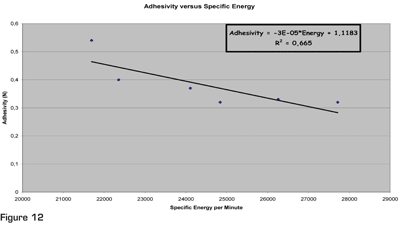Pasta processing and final product characteristics
- Like
- Digg
- Del
- Tumblr
- VKontakte
- Buffer
- Love This
- Odnoklassniki
- Meneame
- Blogger
- Amazon
- Yahoo Mail
- Gmail
- AOL
- Newsvine
- HackerNews
- Evernote
- MySpace
- Mail.ru
- Viadeo
- Line
- Comments
- Yummly
- SMS
- Viber
- Telegram
- Subscribe
- Skype
- Facebook Messenger
- Kakao
- LiveJournal
- Yammer
- Edgar
- Fintel
- Mix
- Instapaper
- Copy Link
Posted: 1 June 2009 | Antonio Nespoli, Semolina Pasta Industrialisation Responsible, Barilla G e R. Fratelli SpA | No comments yet
Pasta is apparently a very simple food, with one ingredient: semolina of durum wheat and one reactant: water. In its native state, the ingredient has two main constituents, which are proteins and starch. The reactant, together with mechanical and thermal energy, is necessary to modify their structure to obtain the final configuration. In Figure 1, a dried spaghetti section, the starch granules and the protein net formed are clearly recognisable.
Pasta is apparently a very simple food, with one ingredient: semolina of durum wheat and one reactant: water. In its native state, the ingredient has two main constituents, which are proteins and starch. The reactant, together with mechanical and thermal energy, is necessary to modify their structure to obtain the final configuration. In Figure 1, a dried spaghetti section, the starch granules and the protein net formed are clearly recognisable.
Pasta is apparently a very simple food, with one ingredient: semolina of durum wheat and one reactant: water. In its native state, the ingredient has two main constituents, which are proteins and starch. The reactant, together with mechanical and thermal energy, is necessary to modify their structure to obtain the final configuration. In Figure 1, a dried spaghetti section, the starch granules and the protein net formed are clearly recognisable.
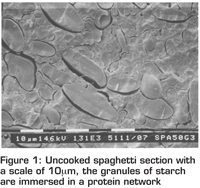

Just to make a comparison, the pasta final product is comparable with reinforced concrete, in which the proteins are the iron rods and the starch is the cement filling. As per the construction material, the structural resistance of the pasta (after cooking in this case) is a function of raw materials and process. There are many works in literature on the interaction between raw material and pasta characteristics and even if it is hard to summarise all the findings, we could say that the quality and quantity of proteins (especially of Glutenin and Gliadins) are the main parameters influencing the final quality. Regarding the current industrial process, we can divide it in two main steps:
Step 1: Water + Semolina + Mechanical Energy → Extruded Pasta
Semolina, whose particles have a variable diameter between 100-500 microns, is weighed with a scale and a defined percentage of water is added. Mixers assure homogeneity in water concentration and the necessary residence time to let water diffuse evenly up to the centre of the granules. The total mixing time is approximately 10-15 minutes with classical mixers; this value is correlated with the diffusion time of water in the semolina and depends of course on the raw material granulation distribution. The wetted semolina is then subject to the extrusion stage, here specific weight passes from 0.75 to 1.35 Kg/dm^3 and the main part of the mechanical energy is transferred to the forming dough.
For a typical spaghetti line, the specific mechanical energy given should be in the range of 40-55 Kj/kg with a good mechanical efficiency (at least over 70 per cent). In case these parameters are not respected, we could have, respectively, a lack of work or an excess of thermal energy (with a superheating) given to the dough. The protein network as a result can be damaged as it is visible in Figure 2. Here it is clear as the proteins (coloured in green with a reactant) are concentrated in the middle of the cooked spaghetti section. The lack of protein in the external part is causing an increased starch release (see the damage structure) and uneven cooking. Figure 3 for comparison is for well processed cooked spaghetti.
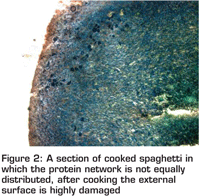

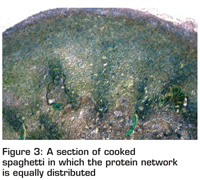

Some of the characteristics of the extruded product are determined also by dies. These are the equipment used to shape the forms. There are two materials currently used: BrAl which is an alloy of bronze and aluminium, and Teflon. The BrAl (commonly identified as bronze) give the classical whitish and rough aspect to the surface of the product, while the Teflon guarantees a smooth and brilliant yellow colour.
As a result, during cooking, the penetration of water is easier for the increased surface in the ‘bronze’ product and whilst eating, it is possible to feel a more uniform consistency compared with the Teflon product. This ‘sensation’ can also be measured using a dynamometer comparing the cutting force to cut 30 per cent of the section and the maximum cutting force.
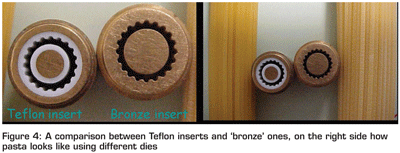

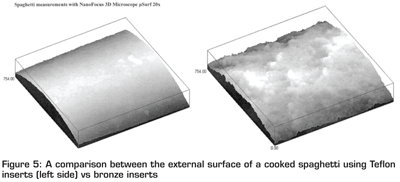

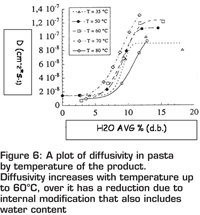



The difference of these values is an indication of the homogeneity of the cooked samples. Comparing samples that differ only for the material of the inserts that constitute the dies, the ‘bronze’ product has a reduced disuniformity compared with Teflon.
After shaping the product, Step 1 is completed. Pasta has a moistness of approximately 30 per cent (w.b.) and it is necessary now to dry it to bring its value to less than 12.5 per cent. In the past, drying was a way to reduce the water activity and to store the product for a long time at shelf condition. With the evolution of the industrial process, this stage can be optimised in order to improve some characteristics of the pasta as, for instance, the consistency. Let’s take a more in depth look at the following part of the production process:
Step 2: Extruded Pasta + Thermal Energy + Ventilation → Dried Pasta
In Figure 8, there is a section of modern spaghetti dryer.
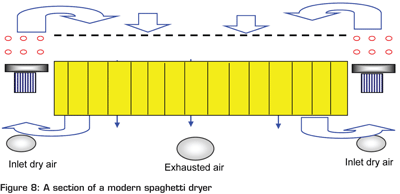

The spaghetti strands (in yellow), hooked at a support named sticks, are hit by an air flow with controlled conditions of temperature and relative humidity. These parameters of air are acquired using probes that, with an automatic system, regulates both thermal energy and dry air inlet to maintain the desired conditions. The length of the entire process is variable depending on the desired type of product. The majority of pasta currently produced is made using a high temperature production line and the drying time for spaghetti is approximately six hours.
Looking closely at what happens in the dryers, we can recognise a coupled process of thermal and mass flow. There is a simple scheme that aids understanding:
- Q1 is the thermal energy flow given with forced convection from hot air to pasta
- Q2 is the thermal energy flow that diffuses from the surface to the centre of spaghetti
- Q3 is the (negative) thermal energy flow that leaves pasta due to the evaporation (that is an endothermic process)
- Q4 is the (negative) thermal energy flow used by the spaghetti structure to create, internally, extra bonds (especially S-S disulfur connections)
- N1 is the mass flow of water that diffuses from the centre to the surface of pasta
- N2 is the mass flow of water that, for convection, leaves spaghetti and passes to air
If we want to write the state equations, simplifying where it is possible we reach this expression:
- Ntot = D* dXpe / dr
- Qtot = S*a*(Ta – Tp) – DHv * D* dXpe / dr
Where:
- Xpe is the mass concentration of water along the radius of spaghetti sections.
- D is the diffusivity coefficient (which is a function of the temperature)
- S is the surface of spaghetti
- a is the convection coefficient
- Ta and Tp are respectively temperature of the air and of the product
- Hv is water heat of evaporation
- r is the radius of the spaghetti section
It is clear that the equations cannot be solved algebraically but only numerically and that they are coupled. This means that both of them need to be solved in the time, in fact, in the mass flow, we have diffusivity that depends on the temperature and in the heat flow, there is the term of water evaporation that depends on the water concentration. It is evident that the limitant stage of drying is the diffusion of water inside pasta. The resolution of the equations, even numerically is complicated from the fact the matrix in which this diffusion is happening changes during the process, so rheologically the material needs to be characterised step by step.
In doing this, researchers identified with high temperature drying two principal steps:
- plastic state that lasts from the beginning of the drying (approximately 30 per cent w.b. of moistness) until approximately 16-18 per cent (w.b.) of water content
- elastic state: characterisation of the properties of this stage is critical in order to have the information to model the process
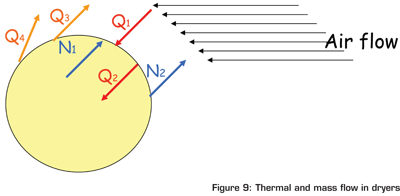

In Figure 10, there is a simulation of an industrial drying cycle using a numerical solution of the above written equations. Measured moistness (blue line) of the product is compared to the calculated one (purple line).
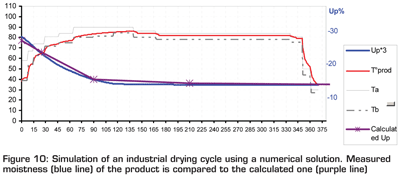

Up to now, we could have good pilot plant simulations, but these findings are not yet applicable to industrial production lines. The principal problem of the scale up, in fact, is that the model works quite well with a single spaghetti immersed in a constant and uniform air flow. Unfortunately, these are not the conditions of spaghetti strands in real production lines and a corrective constant needs to be measured and applied to the model for each type of dryer and spaghetti configuration on the sticks.
Studying the drying cycle, the performance of cooked pasta was measured using a dynamometer that simulates human teeth. The task was to search for a correlation between the thermal energy given and the pasta consistency (through the cutting force needed). In literature, in fact, many works are available that confirm how the ‘al dente’ characteristics improve using the high temperature of drying. This change is surely correlated with structural changes that happen when certain temperatures are overcome. For example, it is clear as diffusivity of water changes going over 70°C (pasta temperature) witnessing important matrix modification (see Figure 4).
Starting from a base drying cycle, some modifications were applied to give spaghetti different quantities of energy both in different stages of drying (plastic and elastic phase) and in different amounts along all of the processing. An interesting finding was described in Figure 11.
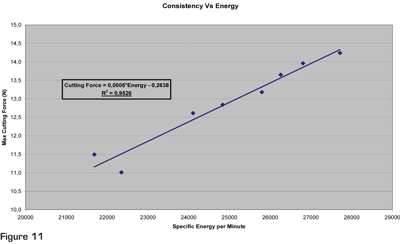

The consistency (cutting force measured with a dynamometer) in Newton is proportional to the total specific energy measured in:
![]()
![]()
The correlation is quite good with a R^2=0.95
With the same dynamometer, it is possible to measure the spaghetti adhesivity, the force necessary to lift up a probe of fixed surface from a spaghetti layer. This can be considered as an approximation of how much starch is present on the pasta surface. Of course, the higher the adhesivity measured in Newton, the higher the starch on the pasta. In this case, the correlation is lower due also to the difficulty of the measurement.
In conclusion, we can say that in the last 100 years, pasta processing has passed from an artisan activity made using natural tools as men work and wind to an industrial business that is highly automated. Making good pasta is still a form of art.
